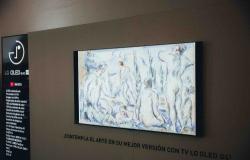There was a time when Bruce Hood viewed everything surrounding positive psychology with skepticism. He seemed to her to be a sphere of naivety and commonplaces, with its universal recipes and its direct highways to happiness. Intermingled in a haze of sweet smell, there swarmed beatific smiles, spirituality for modern times, definitive bestsellers and, occasionally, a certain scientific substratum. To Hood it all seemed too vague, like a pharmacy that offers suggestive balms that are not effective in the long term.
Something changed in 2018, when this British-Canadian developmental psychologist—even then famous for his analyzes of the notion of the self or superstitious beliefs—found out that a former student of his, Laurie Santos, was teaching the course Psychology and good life at Yale University (USA). “She is very rigorous, I knew that she would not be promoting something that did not have good science behind it,” she says via videoconference.
At that time, Hood had begun to detect alarming levels of restlessness among his students at the University of Bristol (United Kingdom). Anguish was rampant within him, fueled by rampant demands, fueled by the digital showcase and its pressure to display joy 24/7. Hood wanted to give evidence-based wellness a chance. He created a program similar to that of Santos, which he named The science of happines. His new book of the same name, published in Spain by Planetadelibros, brings together six years of experiences, his own research and dozens of studies on habits and attitudes that, with data in hand, we know works to make us feel better in a lasting way.
An axis articulates the work: living happier means eliminating egocentrism, that powerful temptation that crosses eras and countries. With his commitment to allocentrism, Hood encourages us to look away from our navel to rest on others. His book invites us to adopt an expansive and countercurrent prism. “In recent years, we have been told that, to be happy, we have to take care of ourselves, put on the oxygen mask before helping others.” Losing sight a little, he maintains, does not imply embracing extreme altruism in which our needs have no bearing. Rather, it is about avoiding a loop of self-absorption by decree: “Happiness focused on oneself has little scope, it greatly limits being at the same time the origin and recipient of our actions.”
Cornering egocentrism goes beyond turning outward. It also requires questioning what we believe we are, what we think defines us. In his work The self illusion (The Illusion of the Self, not translated into Spanish), which was released in 2012, Hood had already dismantled the permanence of something inherent to every human being. The science of happiness abounds in the self as a mirage. “It is nothing new, Buddhism has been asking the same thing for millennia; I have limited myself to giving this idea a scientific vision.”
The self as a “coherent narrative helps make sense of our confusion,” Hood continues, “and that perception of continuity, that we will always be essentially the same person, makes us believe that we make decisions independently.” The ego (I in Latin) seems real, it feels very true. His experience, Hood admits, is undeniable. But it is, at its core, a fallacy, a subtle deception: “There are many factors, most in fact, that are beyond our control, both external issues and unconscious internal dynamics.”
Do these quasi-ontological reflections contribute to our happiness? Hood is convinced it is. “If you want to be happier, you have to give yourself the opportunity to see yourself as a product of your interaction with the world and not as an isolated island,” he says in the book. Conceiving ourselves as a reality under construction, the author argues, is enormously liberating. It allows us to flow more freely and look at ourselves from a greater distance. It helps to loosen the moorings to navigate life without deterministic condemnations, always open to change.
With the ego in the process of demolition and our eyes in allocentric mode, everything becomes softer, less severe. “We become more compassionate with ourselves and with others, it is automatic. If you start to see yourself in a more detached way, you see that the emotional pain that we all suffer originates from a set of causes for which, to a large extent, we are not responsible.” It also reduces pessimism, a mental pattern that tends to take root among egocentrics, who tend to “extrapolate negative events—if something bad has happened once, it will happen more times—and to continually blame themselves.”
Hood maintains that optimism, like any beneficial cognitive habit, requires continuous learning. It is not enough to grasp the message and expect it to remain in our minds forever: we must apply the teachings day by day. There are, of course, truths that help us understand why stress grips us, we are drilled by intrusive thoughts, or we sink into anxiety. One of them, basic, is that “the brain is optimized to look for negative information, to detect problems to solve instead of enjoying things when everything is going well.”
The so-called negativity bias has a compelling evolutionary reason: “Threats, real or imagined, acquire more value. Countless studies show that we pay more attention to what we judge as negative.” In his new work, Hood refers to anxiety (fear in the absence of pressing danger) as a “hangover from our times on the savanna.” Without lions lurking, our neurons are still experts at generating worry. Knowing that they are just doing their job (albeit through often dysfunctional mechanisms), and that the fight or flight response—with its unpleasant physical sensations—is activated for strange reasons, helps maintain serenity in moments of psychoemotional turbulence.
Aware that our heads are designed to create unnecessary torment, we must strive to focus our attention on other things that are more worthwhile. Ruminating less is not always an easy task, but it is key if we aspire to crystallize solid well-being. To make it, The science of happines It displays a wide range of recommendations: meditate, immerse ourselves in our hobbies, admire nature, try psychological distancing… Resources, explains Hood, sufficiently proven in reliable studies.
Much of the book addresses the relational component of a more or less stable joy. Hood recalls that loneliness consistently appears as the factor that most reduces life expectancy, and that “social death” tops the list of human fears. “Our priority objective is not to be excluded, since evolutionarily we have needed to belong to a group to survive.” Although it is not entirely impossible to become a lonely and happy person, the one who succeeds will be the exception that proves the rule.
When relating, it is important to be clear that validating oneself systemically with respect to others fosters an inexhaustible source of sadness and opens a safe gateway to feeling miserable. As children, we are our only reference. But as soon as we become aware as social beings, we begin to qualify ourselves in a market that grows until it encompasses (online life through) all of humanity. We speak, once again, of fertile ground for recalcitrant navel-gazers: “When an egocentric vision of the world predominates, we make endless erroneous comparisons. And there will always be someone better than you in any aspect.” Gratitude is revealed as an excellent antidote to envy and self-flagella. For an obvious reason: “It teaches you to feel lucky.”
The science of happines It synthesizes the most relevant research on the great aspiration of the human being. Hood is not unaware that he faces a devilishly complex field of study, multifactorial like few others and highly dependent on context. “Happiness means different things in different places and to different people.” Among the hundreds of questions raised by this issue, Hood highlights the one that links socioeconomic and emotional well-being. What is the minimum material to be happy? For the moment, shadow areas predominate: “Psychologists and economists do not stop arguing about it without reaching a consensus. The debate does not stop.”
Given the proliferation of scientific literature around what makes us happy, a meta-analysis published at the beginning of the year in Annual Review of Psychology dissected the scientific aptitude of dozens of publications. Few passed the filter. “I think that too rigorous criteria were applied, leading to a somewhat unfair evaluation,” estimates Hood, who acknowledges, however, that there are no shortage of studies that are “statistically poor, with dubious methods or samples that are too small.”
The professor from the University of Bristol insists that, although there is still a long way to go, a robust body of evidence is emerging that illuminates the path to happiness. He repeats that cultivating contentment requires a pick and a shovel: “Perseverance is essential. Certain habits must be consolidated; If not, you are likely to experience setbacks.” And he warns about the counterproductiveness of aiming for perpetual joy: “You have to experience problems and ups and downs. We must not seek a delirium of happiness, but rather learn to be resilient, to look forward, with a certain idea about how we want our life to be.”
You can follow SUBJECT in Facebook, x and instagramor sign up here to receive our weekly newsletter.






